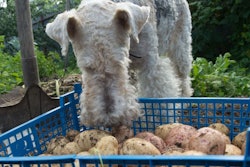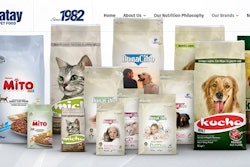
When I reported on upcycled pet treat producer Shameless Pets, it occurred to me that using otherwise wasted farm products as pet food ingredients mirrored dogs’ ancient role as scavengers of human leavings. While scrounging around trash middens may not seem like the pinnacle of healthy eating, it does seem to be what dogs did on the biological path to pet-hood. Now, dogs’ ability to live on what we leave presents a path to reducing pets’ carbon pawprints.
Upcycling refers to using existing materials, especially those that would have been discarded, to make a value-added product. If you made a birdhouse from a milk carton in grade school, that was upcycling. Upcycling goes far beyond arts and crafts now, with whole businesses devoted to finding and repurposing everything from old gym floors to misshapen conveyor belts. In the cases of the food system, otherwise unsaleable consumables become ingredients in new foods, human or pet.
Unused human food items seem a natural fit for pet food. Dogs and cats have eaten what we didn’t since before Stonehenge’s grand opening. Kids are still prone to reducing food waste by feeding unwanted portions to the dog. Like a kid at the dinner table, the human food system often rejects foods it thinks look funny. Misfit fruits and veggies may not fit through processing machines or people won't buy them fresh, for example. However, using crooked carrots and twisted ‘taters to make pet food doesn’t just fulfill the dinner-time adage of waste-not-want-not. Reducing food loss by turning it into pet food ingredients fights the global threat of a destabilized climate.
Food waste, climate change and pet food solutions
Agriculture affect the atmosphere in various ways. From producing fertilizer to flatulent cows to trucking veggies to market, the food system releases carbon dioxide, methane and other heat-trapping gases. While upcycling agricultural products doesn’t solve this problem, it does mean that pollution wasn’t produced in vain. Along with greenhouse gases, upcycling reduces waste of wildlife habitat lost to farmland and water diverted to irrigation.
Food waste equates to tremendous amounts of pointless pollution and wasted resources. The World Resources Institute report “Creating a Sustainable Food Future” presented data that food waste corresponds to 8% of annual greenhouse gas emissions worldwide, or the equivalent of 4.4 gigatons of carbon dioxide. If it were a country, food waste would be the third largest contributor of greenhouse gases on the planet. To grow all that unused food, farmers use a land area larger than China and consume a quarter of irrigation waters. Overall, approximately 24% of food is lost or wasted between production and consumption.
Pet food and treats can use that otherwise wasted food, or at least some of it. Food rescued from waste could replace at least part of a pet food companies need for ingredients. That could reduce the demand from pet food companies for some raw materials or reduce competition between human and pet food streams.
World Resources Institute analysts estimated that cereals, including grains, make up 53% of food loss and waste by caloric content. Fruits and vegetables comprised 44% by weight of lost or wasted food. In total, 1.5 quadrillion kilocalories were lost or wasted in 2009, from 1.3 billion tons of food.
I’d bet many of those lost ingredients could have made some healthy, sustainable pet food.

















